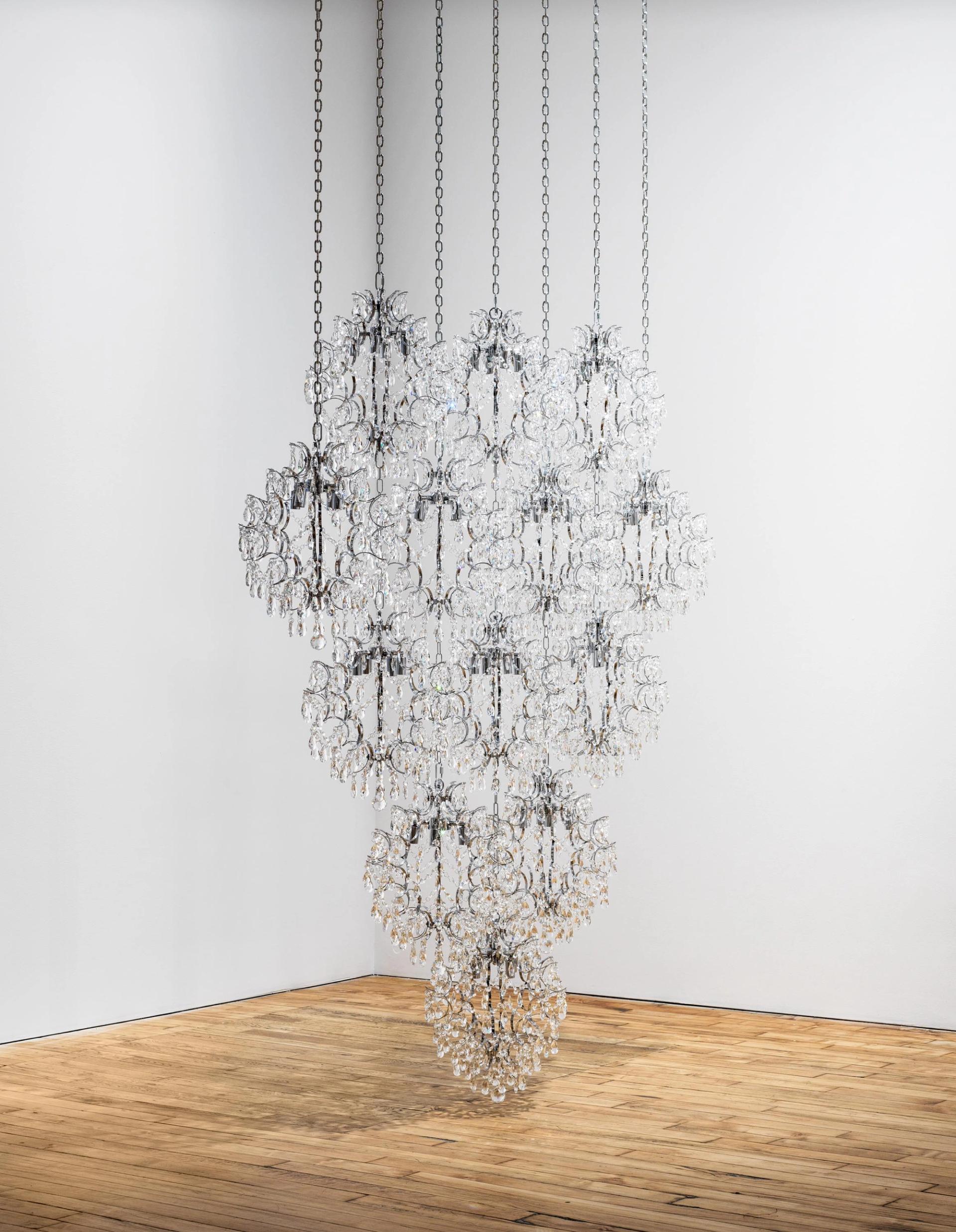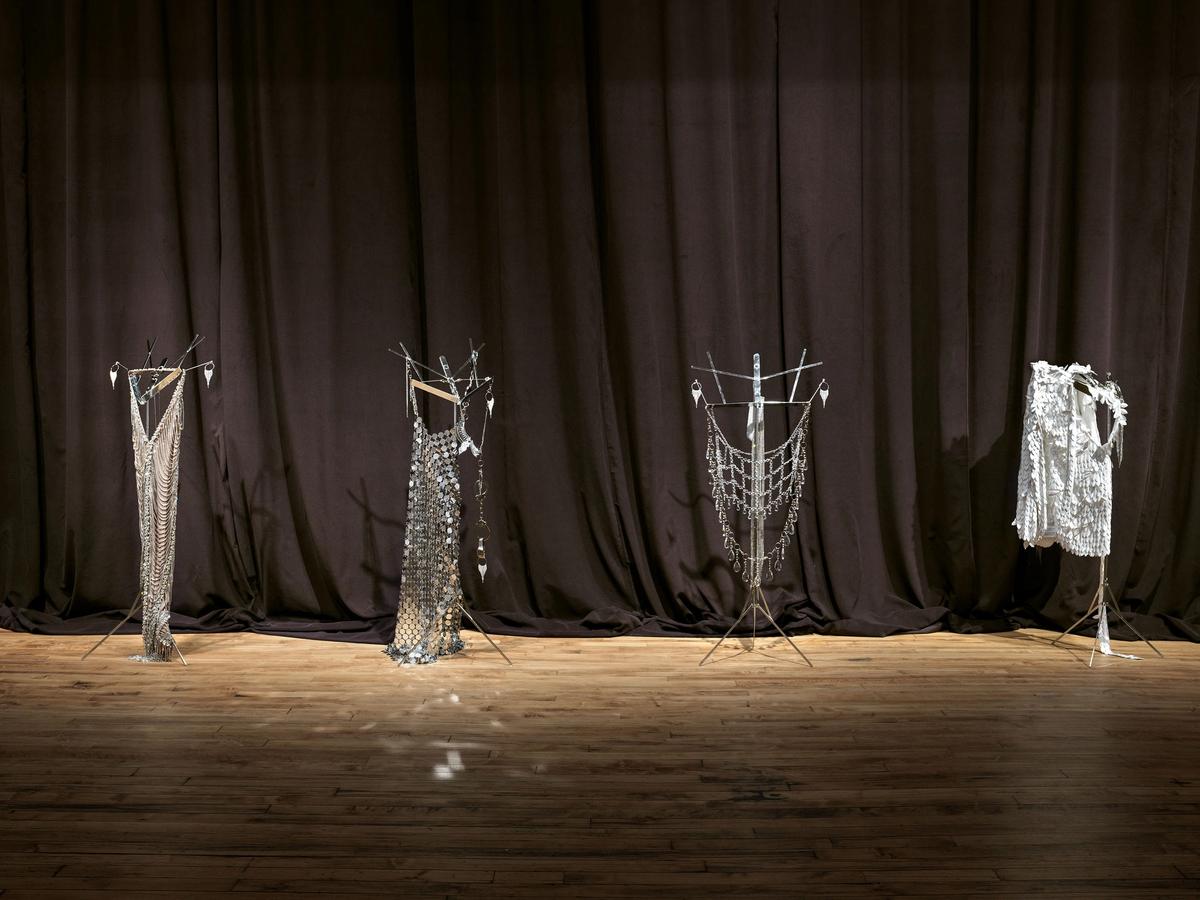Imagine Amazon.com as Modernist Eden. Kayode Ojo does, and out of the studio of the mind where the 33-year-old conceptualist works, he has created a luxe product paradise for 52 Walker that is tantamount to vintage design porn. Though replete with references to the reflective interiors of architect Paul Rudolph, the readymade sculptures of Haim Steinbach, the polished stainless steel of Jeff Koons, and the misbehaviours embedded in a Cady Noland, Ojo’s exhibition reminded me less of 1980s consumer critique than a pawnshop in downtown Las Vegas I once visited.
The store was chock-a-block with sparkling jewels, sequined gowns, and various weaponry that desperate gamblers had sacrificed for another roll of the dice. Ojo’s through-the-looking-glass calculus of desire is spartan by comparison, but no less dazzling and far more transparent. It also has the gowns, the jewelry, and the guns as well as such “adult toys” as prop handcuffs along with Lucite furniture, a giant bird cage housing a giant Magnum 45 and, not to put too fine a point on it, a Bible—all bearing the the stamp of a previous owner.
Each sculpture has a story to tell, some quite personal to the artist. (One chandelier, Esther, is named for the family friend who gave him his first camera.) The exhibition itself is more involved in a mechanics of luxe display that is as destabilising as it is theatrical. It’s also quite sexy, in a remote, careful-what-you-wish-for, mummifying sort of way.
Talk about holding a mirror to the soul. For all its icy but hypnotic brio,Ojo’s exhibition Eden isn’t about the spanking new but the fondly remembered and the fetishised associations that spin out from it.

Installation view of Kayode Ojo: Eden at 52 Walker, New York
After coming across a photo of an appearance by the Supremes in their heyday, Ojo searched for spangled, beaded, sequined, feathered and rhinestone-studded showgirl costumes and bought four slinky, glittering dresses, though one is barely more than a breast plate. He has them draped over music stands lined up like streetwalkers before a dark brown curtain that runs the length of a wall and gives the whole gallery the feeling of a ghostly cabaret. A silver revolver is tucked into one dress stand; handcuffs dangle from another like mittens secured to a child’s snowsuit. Glamour can be dangerous when it bites.
“I have an obsession with Paul Rudolph,” Ojo confesses, “and also the Tom Ford of Gucci.” (Ford bought the multi-level Manhattan townhouse that Rudolph designed for Halston.) “He is provocative as a person but what people flock to is the vision, which they can’t articulate for themselves.”
No matter. They can look to Ojo. One of four siblings born to Nigerian immigrants who are both religious academics attached to a college in Cookeville, Tennessee, he grew up in an integrated community about an hour from Nashville. “I never had any trouble there,” he says. “It was great.” It was also too small, and he left for New York to study photography at the School of Visual Arts before finding himself in sculpture as an assembler of appropriated parts.
Nostalgic yearning creates its own distortions of reality; what lives in the mind’s eye is not what arrives from Amazon or any fast-fashion site. Sometimes a purchased item will turn out to be larger than imagined or too small to fit. “One dress came with a hair caught in it,” Ojo told me. He left it in, with a whole lot more.
The white leather, Le Corbusier-style armchair from which Sharon Stone teased her interrogators in Basic Instinct sits like a throne on a brightly lit bathroom mirror; a vintage Speed Graphic camera once favoured by paparazzi sits in her place, its lens trained on the viewer.
An over-scaled pocket watch that should be a wall clock hangs by a long steel chain from the ceiling to the floor as a becalmed pendulum that serves no purpose other than teasing the eye. Likewise, two outsize chrome and crystal chandeliers worthy of a New Orleans bordello are suspended by chains on either side of the gallery like drop earrings too heavy to lift above ankle height; each is composed of about a dozen individual chandeliers that together make a nearly blinding declaration of fractals. Smoky martini glasses are stacked, not glued, into a pyramid that barely holds it shape; lifting one glass would send them all flying—along with the several rotted human teeth sitting in them like olives.
One may think that consumer critique had long overplayed its hand, but that was before online shopping became a big thing. As it is, Ojo’s sculptures have less to say about art as a commodity than it does about the psychology of marketing and the language of seduction employed by online retailers to snag customers willing to one-click for items they’ve never touched, smelled, or tested. (Hello, art market.) If you can’t afford the astronomically priced vintage object of your dreams, you can get a cheaper reproduction that looks just as good. Just keep scrolling and you shall receive.

Installation view of Kayode Ojo: Eden at 52 Walker, New York
The list of materials that follows the title of each installation tell the tale. Embouchure is an enormous rope ladder that Ojo suspended from the gallery’s 16-ft ceiling in a U shape that touches the floor. It suggests the leather slings of a BDSM sex club, only the climbing bars are shining, nickel silver flutes, an impression that its online product description— “Glory Closed Hole C Flute….Joint Grease and Gloves”—does nothing to impair.
Ojo improvised the works in Eden and their size and placement is specific to the space of the gallery, an outlier as commercial entities go. Though connected to the Zwirner Gallery empire, 52 Walker operates as an autonomous curatorial project for its director, Ebony L. Haynes, who develops exhibitions over the course of a year with each of the “researched-based” artists of colour who dominate the programme. Notably, most are not represented by Zwirner.
“We modeled it on a kunsthalle,” says Haynes. It works remarkably well as both an exhibition space and a study centre. Shows remain on view longer than is usual in galleries and each show gets its own Clarion Books publication. In addition, the gallery has a free lending library of books selected by the artists, for whom they have been source material.
“Good ideas are persuasive,” says Haynes, who has a ten-year history with Ojo. The two worked together for his first solo shows at Martos Gallarey. In Europe, he’s on the rosters of Sweetwater in Berlin and Balice-Hertling in Paris. Eden is his thirteenth solo show to date and his most assured. “It’s intense having a solo show in New York,” he says. “The jewlery is all about sexual display. When I wore gold jewelry around my neck, people did reach out to touch me.But if ou touched anything in this show, it would fall apart. I’m not so obsessed with leaving a mark, like a painter. It’s more like trying to disappear.”
Not a simple task amid all those mirrors and transparent Plexiglass but as Jasper Johns once said: "The eye sees what the mind already knows."
• Kayode Ojo: Eden, 52 Walker, New York, until 6 January 2024


